16 Amazing Castles In The East Of Scotland
Exploring castles in the east of Scotland is one of my favourite things to do. Hopefully, it will help you decide on what castle to visit, as there are so many to choose from.
Scotland is well-known for its turbulent history, king and queens, local legends and myths. One of the best things to do while you are in Scotland is to visit one of Scotland’s castles.
Castles are an integral part of the Scottish landscape along with lochs and the mountainous landscape. This post explores well-preserved castles, castle ruins, manor houses and palaces.
Many of Scotland’s castles were created centuries ago. An excellent opportunity to learn about the families who set foot in them and what life used to be like.
The castles listed below are located in the eastern half of Scotland all the way from the Highlands to the Scottish Borders.
Castles that have made this list are in the Highlands, Moray, Aberdeenshire, Angus, Fife, Edinburgh, Lothians and Scottish Borders. Interestingly, Aberdeenshire is the area with more castles per acre than anywhere else in the UK.
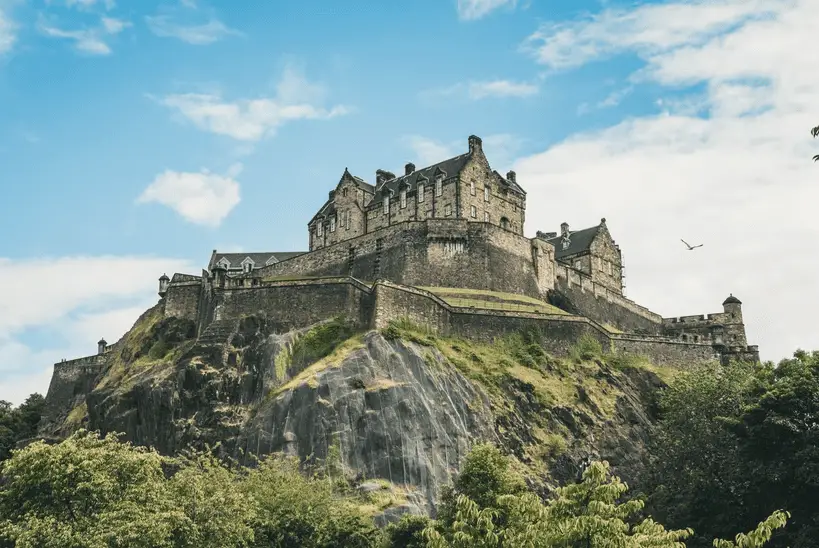
Edinburgh Castle, Edinburgh
This is one of the most famous and popular attractions for international and domestic visitors alike. The castle is perched on an old volcanic rock above the centre of Edinburgh.
A highlight of the Old Town of Edinburgh at the end of the Royal Mile in the UNESCO World Heritage Site.
You are free to roam in the order you want to see inside the buildings as you desire. Hours can be spent here, even though it is not one hundred per cent accessible.
Just a reminder if you are there at 1 pm there is a firing of the cannon. Guided tours are provided by castle stewards, also, there is an option for audio tours.
The audio tours will explain the architecture and dramatic history of the castle. Edinburgh Castle has dominated the skyline for centuries.
From the front of the castle, you will get rewarding views across Edinburgh to the Pentland Hills to the south and to Leith in the north. The view is even more stunning on a clear day.
The Royal Edinburgh Military Tattoo is located just outside Edinburgh Castle in the month of August during the Fringe celebrations.
The Military Tattoo celebrates musicians and performers from all around the world. Spectators from all around the world are welcome.
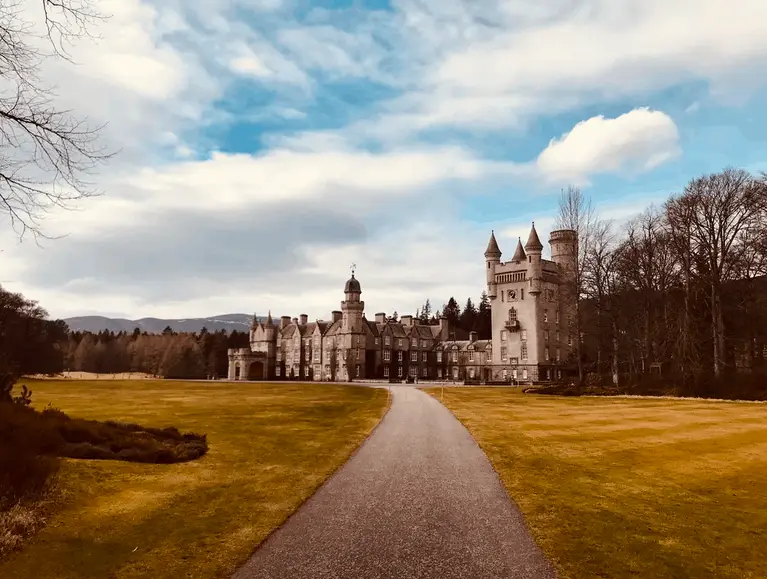
Balmoral Castle, Aberdeenshire
The Scottish home for the Royal Family. The large estate house is located near the village of Crathie and is not far from Ballater, in the Cairngorms National Park.
The closest city to Balmoral Castle is Aberdeen. Balmoral has been in possession of the Royal Family since 1852, when Prince Albert purchased the land for Queen Victoria.
The current castle was completed in 1856. The current Royal Family spend most of the summer months here, thus, the palace and grounds are usually closed to respect the family.
Queen Elizabeth II passed away in September in Balmoral Castle. Balmoral Castle is open to the public from April to July each year.
These grounds, gardens, exhibitions, gift shops and coffee shops are open to the public on a daily basis. Outside this period, group visits can sometimes be arranged when the Royal Family is not in residence.
Audio tours are available in different languages, tours showcase the relaxing grounds, interesting exhibitions and glamorous Ballroom at Balmoral.
The audio takes approximately one hour. Also, the Ballroom is the only room in the castle which is accessible to the public.
Outside the grounds, there is a stunning countryside walk which features the best cairns which were built during the Victorian Era. As well as the interesting cairns and the large pyramid you can have a view of Balmoral Castle from the hills.
Nearby, is Crathie’s Kirk where the Queen used to go for Sunday service. Balmoral Castle is a good castle for people to visit who are coming from Aberdeen.
Also, make sure to pay a visit to the Highlander Bakehouse for delicious hot chocolate and Biscoff teacakes. Car parking at the castle costs £5.
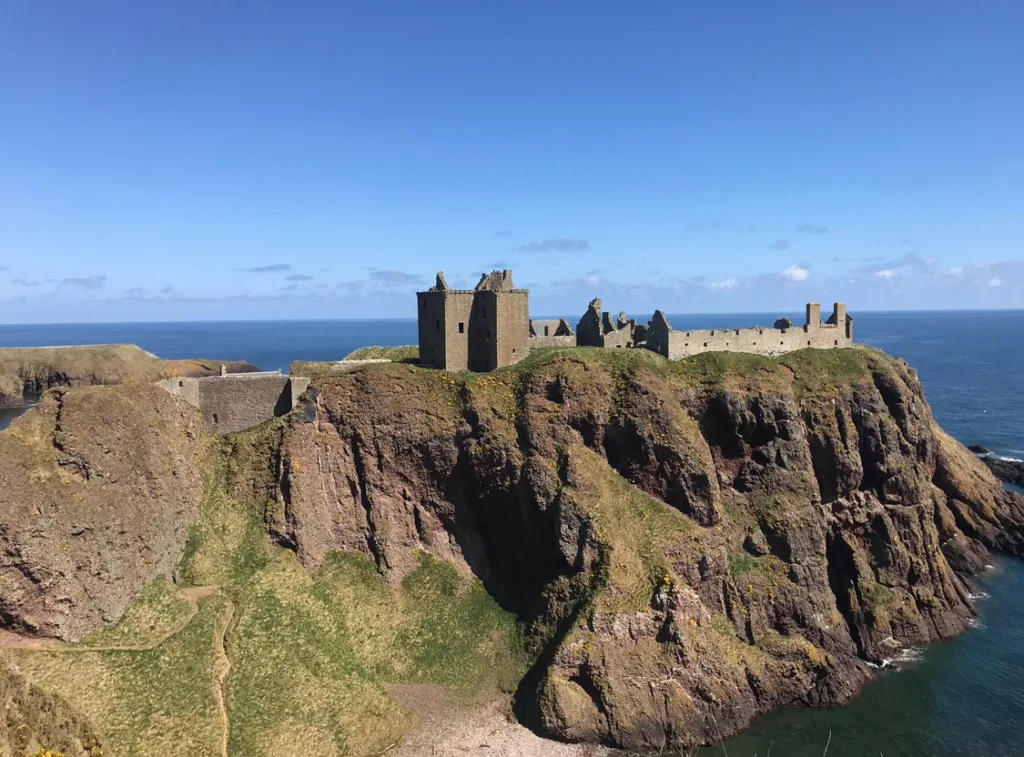
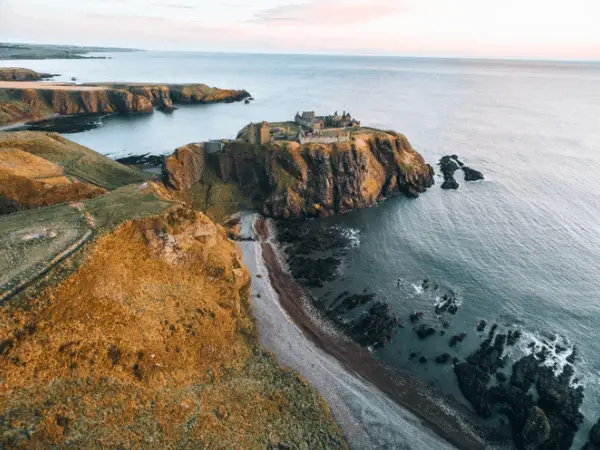
Dunnottar Castle, Aberdeenshire
Located just south of Stonehaven, is the spectacular ruins of Dunnottar Castle. Perched on top of a 160 feet rock, the North Sea fills the surrounding on almost three sides of the castle.
Long, these dramatic ruins were once an invincible fortress belonging to one of the most powerful families in Scotland, the Earls of Marischal.
The castle has a turbulent history and Dunnottar has been a residence for many historical figures. William Wallace and Mary Queen of Scots have set foot in the castle.
Also, Dunnottar Castle was the place of safekeeping of the Scottish Crown Jewels, from Oliver Cromwell’s army in the 17th century.
This castle is a paradise for photographers, a haven for history buffs and a top tourist attraction. Nearby, you can wander along the dramatic cliff tops, peer down to the sandy coves and spot Stonehaven in the distance.
Also, there are forest walks nearby, along with an RSPB nature reserve and a waterfall which tumble down the side of the cliff face.
Aberdeenshire’s alluring coastline near the historic town of Stonehaven makes the area a perfect place for a day trip. Entry to the castle costs £9.50.
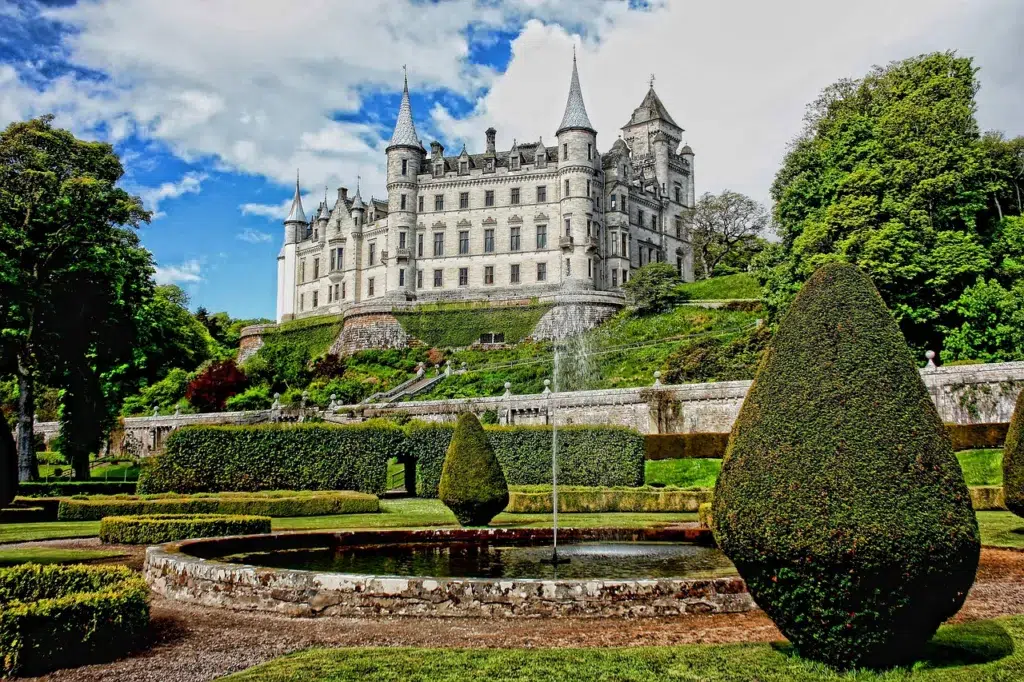
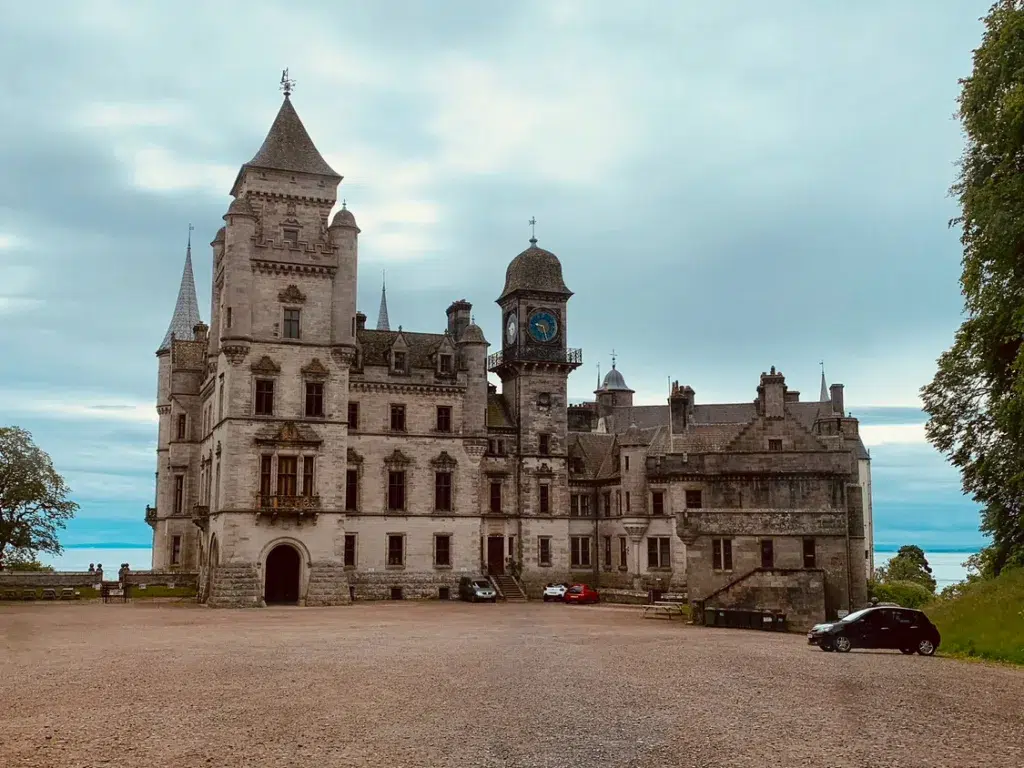
Dunrobin Castle, Highlands
With 189 rooms, Dunrobin is one of the great manor houses in the North Highlands of Scotland. The large white exterior equipped with turrets and a well-maintained colourful garden looks like something straight out of a movie.
Since the 13th century, Dunrobin has been the home to the Earls and Dukes of Sutherland.
Interestingly, Dunrobin has been influenced by the work of architect Charles Barry, who designed London’s Houses of Parliament and Scotland’s own Sir Robert Lorimer.
During the First World War, the castle was used as a hospital and from 1965 to 1972 it was used as a boys’ boarding school.
A popular stop as part of the North Coast 500. Inside the castle, there is a museum, gift shop, a very nice and outside there are regular falconry displays.
Also, There are fabulous rooms inside which have so much interesting history and family decorations.
The location of the castle is perfect. There is a woodland near the front of the French-style castle, meanwhile, the gardens separate the castle and the North Sea.
From the castle, you will receive amazing views of the North Sea. Also, the east coast of the Northern Highlands is on display, as well as the Moray Firth, just north of the villages Golspie and Dornoch.
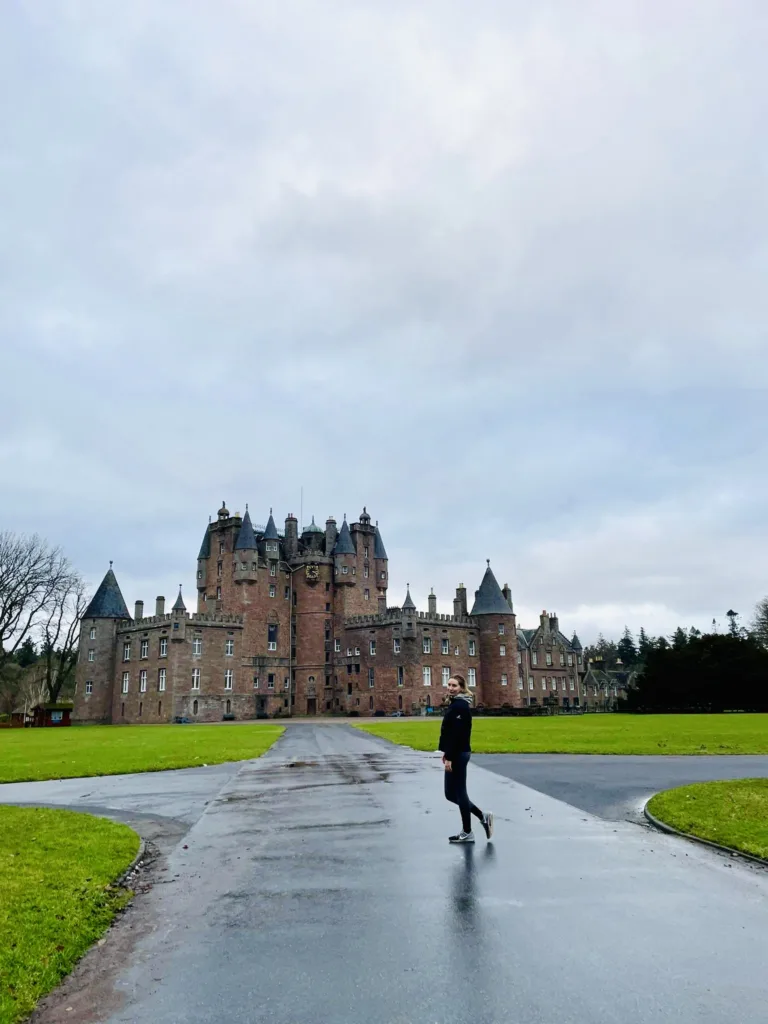
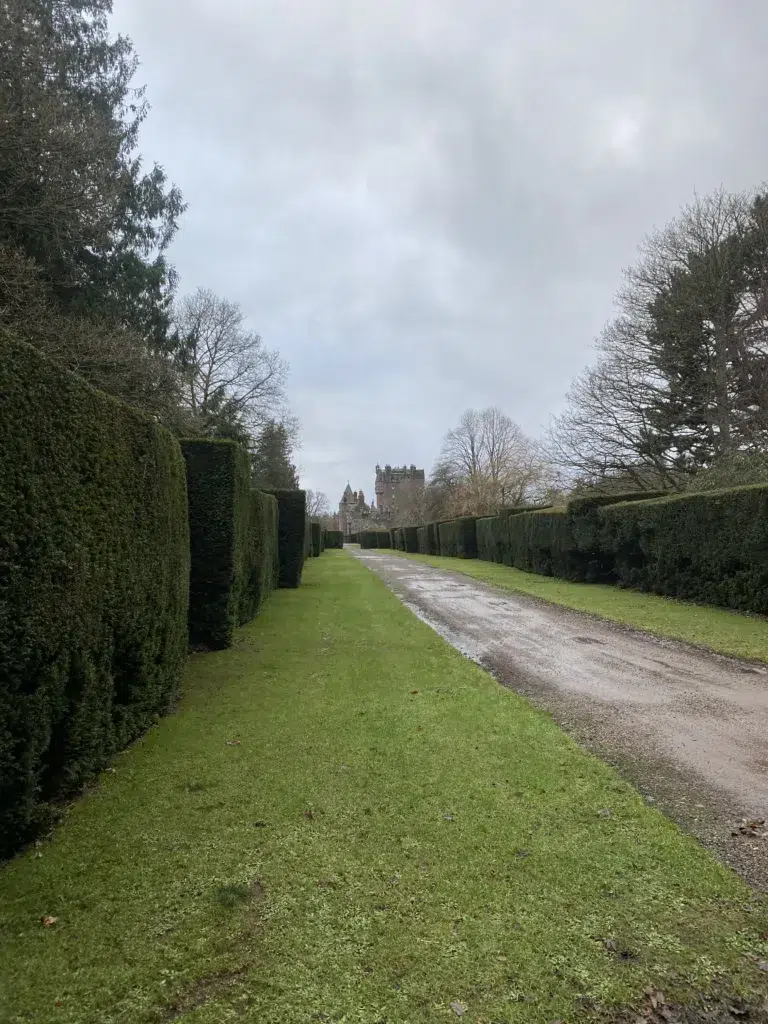
Glamis Castle, Angus
Located in the heart of Angus, near a small village called Glamis. A short drive from the small town of Forfar, not far from the main city, Dundee.
This castle in the east of Scotland is one of the grandest and the beautiful red stone palace is a magnificent sight. Also, it is full of heritage, hospitality and enjoyment for all.
Glamis Castle has been the ancestral seat to the Earls of Strathmore and Kinghorne since 1372. Sir John Lyon, Thane of Glamis received the land as a gift from King Robert II.
Glamis has links to the Royal family, it was the childhood home of the Queen Mother, Elizabeth Bowes-Lyon. Also, HRH Princess Margaret was born here.
Tour guides will help you follow in the footsteps of Mary, Queen of Scots, James V and Bonnie Dundee. Moreover, you can learn about the story of Mary Eleanor Bowes.
During your visit, you can top for something to eat in the original Victorian space. Glamis Castle Kitchen serves morning coffee, lunch or afternoon tea.
The food is made from the best seasonal produce and is freshly prepared. Also, the food is made with locally sourced ingredients from the Estate’s own farms and gardens.
Glamis Castle is a popular castle to visit for those who are coming from Dundee.

Craigievar Castle, Aberdeenshire
Next on the list for the best castles in the east of Scotland, is a romantic Aberdeenshire Castle. Craigievar Castle is a gorgeous pink 16th-century castle which has been well-preserved.
The exterior of the castle has been mentioned to have influenced Walk Disney and the design of Cinderella Castle. Built-in 1626 by William Forbes, his descendants continued to live in the house until 1963.
If fairy tales were true, all castles would look similar to Craigievar. A great example of Scottish Baronial architecture, the enchanting structure fits gracefully into the rolling hills of Aberdeenshire.
The interior is a quirky mix between modern comforts and rare antiques. Craigievar Castle is one of the three castles in Scotland which is known for having finely decorated ceilings.
Also, inside you can explore the impressive collections, artefacts and art including Raeburn portraits, Jacobean woodwork, armour and weapons.
Moreover, you can enjoy a peaceful stroll around the garden and estate. There are two way-marked woodland trails to explore and a Victorian kitchen garden.
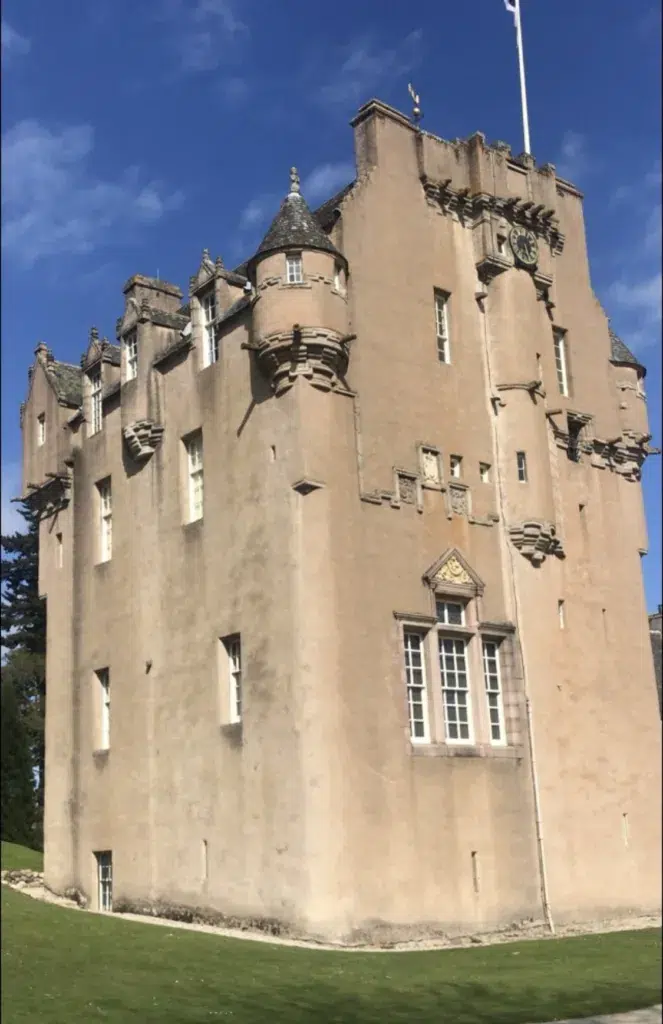
Crathes Castle, Aberdeenshire
A stunning 16th-century classic Scottish tower house, located in the splendid Aberdeenshire countryside. The castle features many of the original features including a maze of turrets, towers, oak panels and painted ceilings.
Similarly style to Craigievar Castle from the outside, without the pink colourful exterior.
Back in 1323, the Burnett family were granted the lands of Leys by King Robert the Bruce. Also, Robert the Bruce gifted the ancient Horn of Leys, which is a well-known feature placed in the Great Hall.
Rich in cultural history, from family portraits to fine antique furniture. Be prepared for the hike up the vertical spiral staircase.
As well as the magnificent castle, there are beautiful gardens which are well cared for.
These gardens feature the historic walled garden which has iconic yew hedges, planted as early as 1702. Also, the gardens showcase a sculpted topiary, soft herbaceous colours and modern exotic blooms.
Moreover, there is a wider estate to explore. There is plenty of woodland with clearly signposted and way-marked trails.
Go Ape the high ropes course is located in the woodlands. You can zoom between trees on a zip wire, and experience the heights of the Green Lady’s Tower.
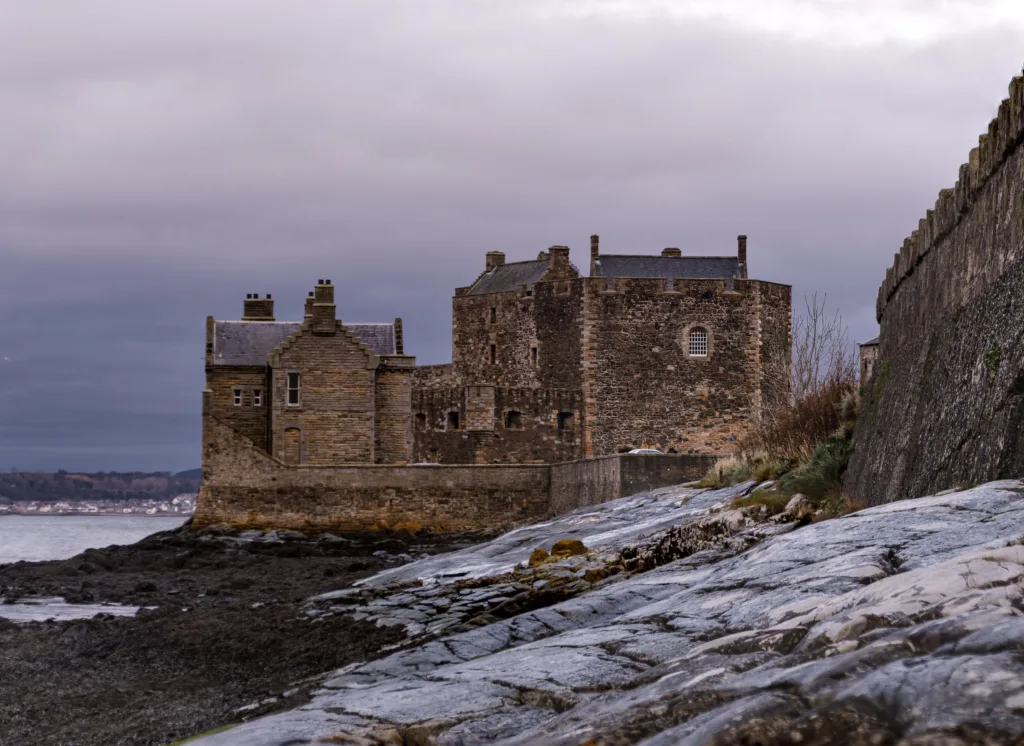
Blackness Castle, West Lothian
This 15th-century castle is unique and interesting as it is located right by the water of River Firth, near a harbour village. There is a perry pier and cool views from one side of the castle.
You will be rewarded with fantastic views across the three bridges crossing the Forth.
Blackness Castle is known as the ‘ship that never sailed’ due to the square stern, tall mast and pointed stem. It is one of the most historic castles on the east coast of Scotland.
Primarily, Blackness Castle was used as a garrison stronghold and a state prison on behalf of the reigning sovereign. In later medieval times, many famous prisoners were held here.
Also, Blackness Castle has been a popular place for shooting film and TV series.
Some of you might recognise the castle from the 1990 movie Hamlet, the 1996 movie The Bruce or from series 1 of Outlander where Blackness Castle stood in for ‘Fort William’. More recently, the castle featured in Mary Queen of Scots (2018) as the Palace of Holyroodhouse.
Currently, the castle is open daily for self-guided tours. The central tower can be climbed to get spectacular unspoiled views of the local area.
Blackness Castle is near Falkirk and is on the Forth Valley Tourist Route.
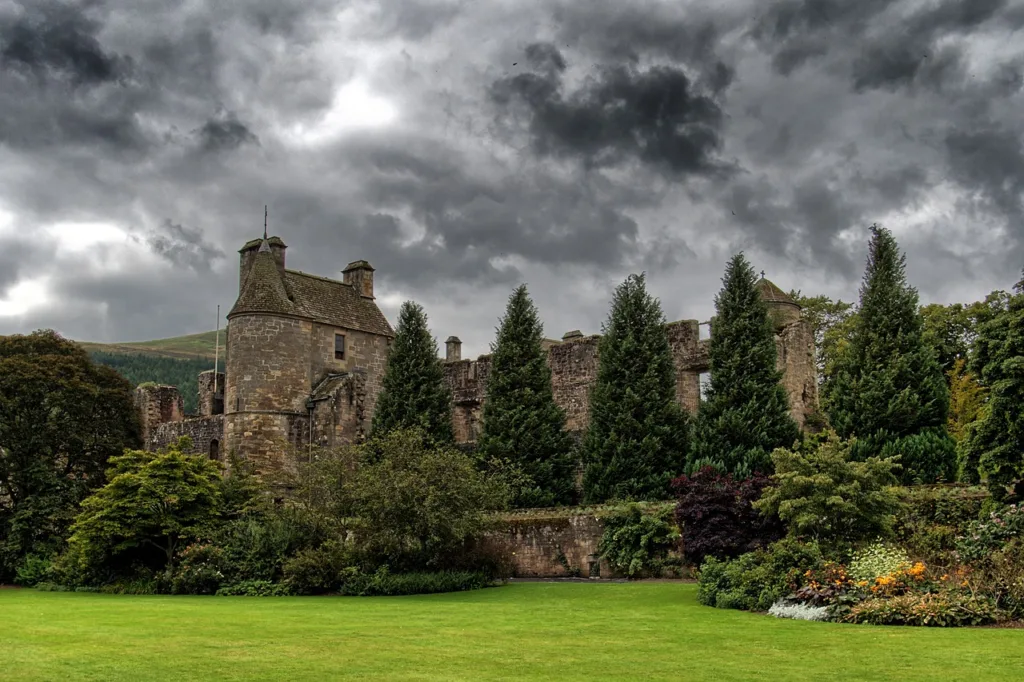
Falkland Palace, Fife
Falkland Palace is known being one of Scotland’s finest Renaissance palaces. Back in the early 16th century, a ‘pleasure palace’ was created by King James IV and his son James V.
The best craftsmen and architects were brought in to complete the project. The palace reflected their finest hobbies including falconry and hunting.
This is one of the finest palace castles on the east coast of Scotland. Famous for its beautiful gardens and tennis courts, which are presumably the oldest tennis courts in Britain as it was built in 1539.
The tranquil gardens are home to an ancient orchard with a wildflower meadow. Also, the extensive formal gardens include a physic garden with Renaissance-era herbal remedies.
From the outside you can admire the spectacular turrets and archways. Inside, there is so much beauty and history to take in while you are wandering through the palace, from the drawing room through to the library.
Also, you can explore the superb Chapel Royal and the vast range of 17th-century artefacts inside the palace. If you pay a visit to Falkland Palace, make sure to take time to wander the streets of the charming village of Falkland.
I remember visiting the palace and village as part of a primary school trip. The tour of the castle was very exciting and engaging.
Falkland Palace is located in the pleasant small village called Falkland. I remember being shown the streets of Falkland and the curvature of the stone walls on the street to make room for the horse-drawn carriages.
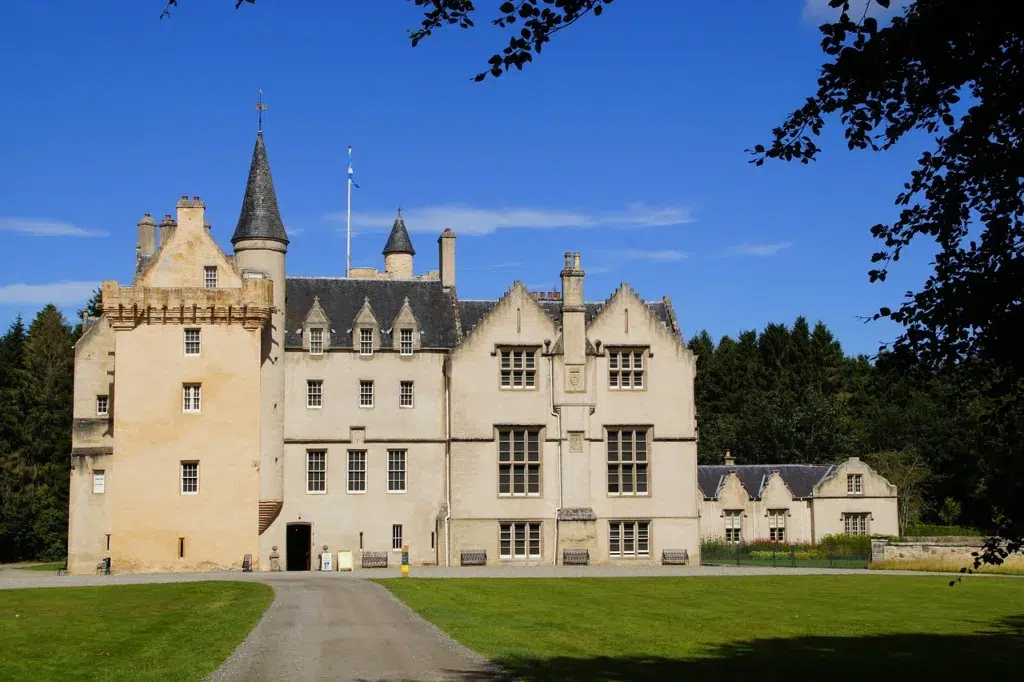
Brodie Castle, Moray
Brodie Castle was home to one of the most prominent families in Scotland.
For over 400 years, the rose-coloured castle has been the ancestral home to the Brodie Clan. Although their family seat has been here since the 12th century.
A guided tour will take you back to the castle’s glory days. You can learn about how the castle’s purpose has changed over the centuries.
The 16th-century guard chamber is bound by a 17th-century wing and by another Victorian extension.
There is an impressive art collection to admire including 17th-century Dutch Old Masters to modern watercolours. Also, the castle houses a magnificent collection of ceramics, and furniture and hosts a library of 6,000 volumes.
This is one of the most immaculately kept grounds of the castles on the east coast of Scotland. Also, the gardens are perfect for all ages including a famous large bunny sculpture.
Daffodils decorate the grounds in the Spring months. Characters that have played a part in the history of the castle are involved in the Playful Garden.
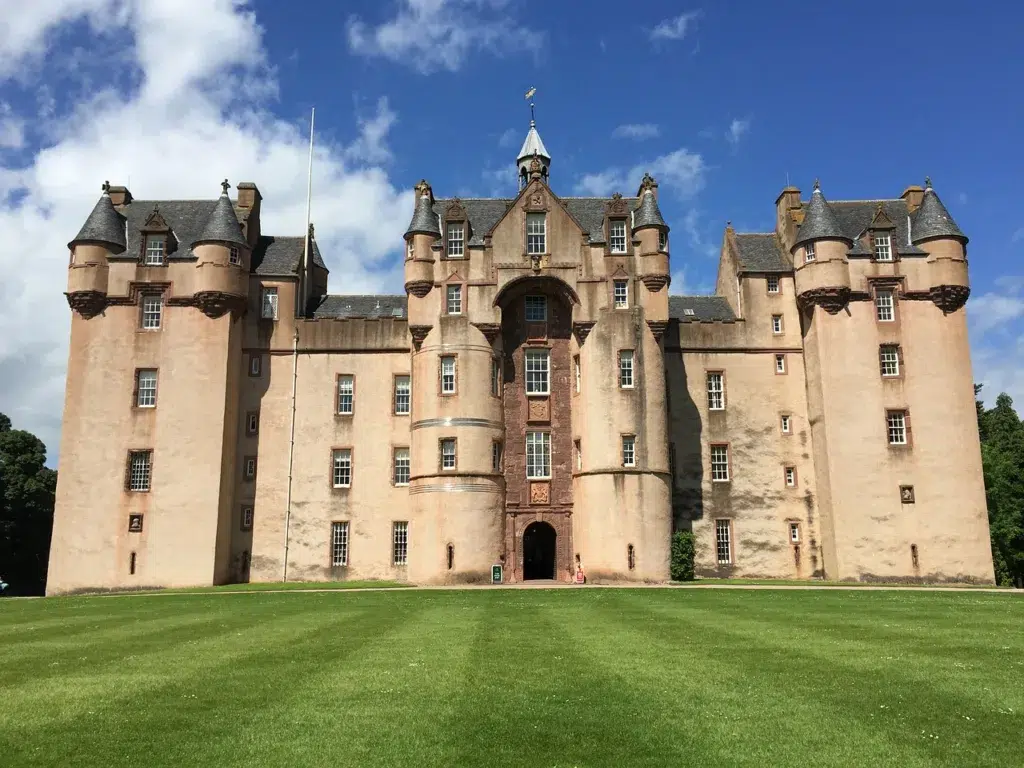
Fyvie Castle, Aberdeenshire
A stunning 4 storey 13th century castle, located in the heart of Aberdeenshire. Fyvie Castle is a prime example of Scottish Baronial architecture.
Edwardian interiors including a portrait collection, lavish oil paintings, ancient armour and wonderful antiques fill the exquisite rooms. Also, the castle has a bowling alley.
Fyvie has been established for over 800 years. It is full of history, ghosts, legends and folklore.
The castle has welcomed many iconic guests including William the Lion, Robert the Bruce and Charles I. You can go on guided tours with interesting facts about the castle and the families that have lived here.
There are lots of Instagrammable areas for beautiful pictures. Outside the gardens are grounds just as exquisite as the interior.
There is a lovely lake and an unusual glass-roofed racquet course, an ice house, bird hide and a restored earth closet. The walled garden is jam-packed with stunning flowers, fruits and vegetables.
As well as the castle garden there is a café which serves simple but delicious food. Fyvie Castle is one of the many impressive castles located in Aberdeenshire.
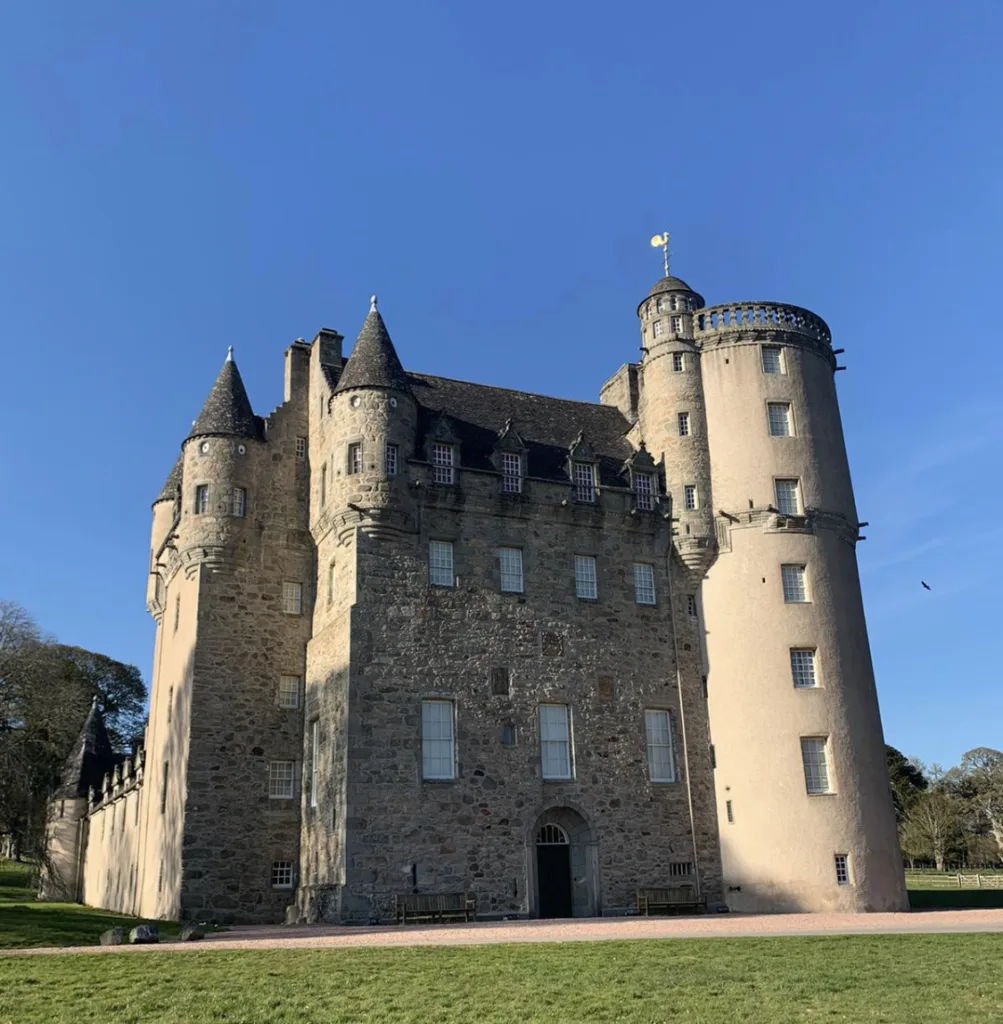
Castle Fraser, Aberdeenshire
A large superb tower house in Scotland is located in rural Aberdeenshire. Since the 15th century, later additions were added to the structure to make Fraser one of the biggest tower houses in the country, set out over seven floors.
Castle Fraser was built as the home of the Frasers of Muchalls, later the Frasers of Castle Fraser. The castle is filled with portraits, ornaments and mementoes which show a deep dive into the family history.
Discover quirky features such as secret staircases, hidden trapdoors, a spy hole and a wooden leg, as well as gorgeous panoramic views from the tower top. A reminiscent room in the structure is the mediaeval Great Hall.
There are two trails and tracks to follow which lead to spectacular views of the local hills. Also, the estate has a flight pond, mixed woodland and open farmland.
Specimen trees, herbaceous borders and organically grown fruit and vegetables fill the traditional walled garden.
You can view the grounds and gardens for free. Also, there is a shop selling exclusive gifts, a tea room and plenty of parking.
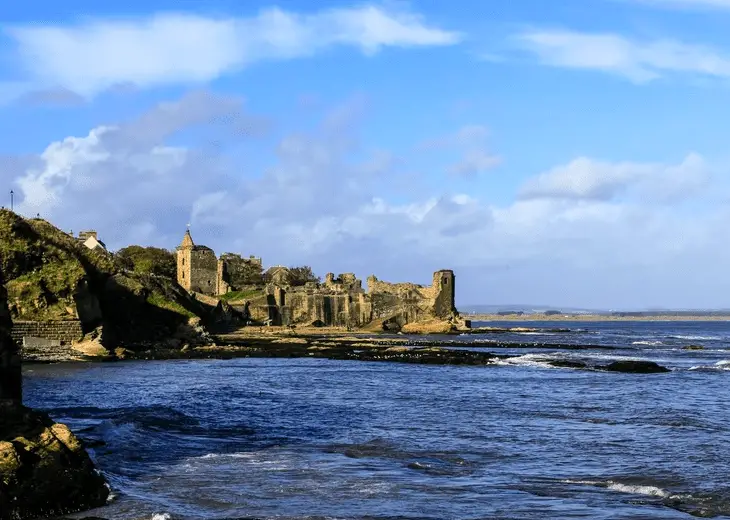

St Andrews Castle, Fife
Located on the east coast of Scotland, in the historic town of St Andrews is the dramatic castle ruin of St Andrews Castle. Once was a focal point of the church in medieval Scotland.
Also, the castle was once the main residence of bishops and archbishops of St Andrews. It is a great experience walking through the ruins and learning about the violent history.
One of the most memorable experiences from this visit was exploring the secret passageways and the old dungeon. The dark space cuts underground into the rock and it is believed to have stretched out across the road.
The 16th-century siege mine and counter-mine are worth exploring. Well-known prisoners include John Knox and George Wishart.
This is one of the most historic ruined castles on the east coast of Scotland. The site is currently managed by Historic Environment Scotland.
Floors Castle, Scottish Borders
One of the most iconic country houses in Scotland. Over the past 300 years, eleven generations of the Dukes of Roxburghe have passed through Floors Castle.
The Dukes of Roxburgh still live in the estate house today. The castle is breathtaking, like something from a fairytale.
Inside the castle, there is an excellent collection of fine art, porcelain, tapestries and grand rooms.
This interior is one of the most glamorous castles on the east coast of Scotland. Also, there are amazing views across the River tweed and the Cheviot to the south.
Leading architect William Adam built the castle in the 18th century between 1721-1726. Burning the Victorian period, further changes were added to the castle by Scottish architect William Playfair.
Very few castles in the UK match the elegance of the estate. It is still an iconic piece of Scottish architecture.
There is so much to discover at Floors. Stroll along the riverside or wander through the atmospheric woodland grounds.
There are Victorian walled gardens which have glasshouses, herbaceous borders and a formal Millennium Garden to marvel at.
Tray bakes and delicious lunches are available at one of the two cafes – Terrace Café Apple Shed Deli.
The terrace and Courtyard Cafes are ideal places for a takeaway snack to enjoy on the grounds. Also, there are afternoon teas available.
Events and activities are organised all year round. If you are in the Scottish Borders this castle is a must-see.
The landscape, locations and everything are just perfect. A ticket to the castle, gardens and grounds cost £18 per person, and a grounds-only ticket costs £10 per season.
Thirlestane Castle, Scottish Borders
A restored country house with Victorian wings and formal gardens. The 16th-century building is set in the beautiful Lauderdale Estate in the Scottish Borders.
The journey from Edinburgh is only 40 minutes. This is one of the most southerly castles on the east coast of Scotland.
For over 400 years the Thirlestane Castle has been home to the Maitland family. It is the ancient seat of the Earls and Duke of Lauderdale.
A splendid building which features 18th-century plasterwork ceilings, fine furnishings, pictures and Maitland family trees.
The bedchamber belonging to the Duke is one of the most impressive rooms in the castle.
Also, it is worth exploring the State Dining Room and admiring a collection of family portraits. Weapons dating back to 1745 decorate the entrance hall.
Guided tours are available. The rooms are well decorated, and the interior makes this castle one of the best in Scotland.
The guides are very knowledgeable and make you feel very welcome and at home in this gorgeous castle. At the end of the tour, you are offered a complimentary cup of tea and a chocolate biscuit.
Also, there is a museum which explains what life used to be like in the Scottish Borders.
The Toy Museum ‘School Room’ has an impressive collection of Georgian, Edwardian and Victorian toys, you can explore the toys throughout the ages. Tickets to the grounds only cost £3.50

Slains Castle, Aberdeenshire
Slains Castle is located on the coast of Cruden Bay. The Earl of Errol reconstructed the castle in 1597.
The ruins are located on stunning green cliffs, making the photos look amazing. Back in the early 19th century, many celebrities were entertained here.
One of the most notable guests includes Bram Stoker, it is believed that the castle was the inspiration for the setting of the tale of Count Dracula. Also, The Crown fans will also recognise Slains Castle from season 1 of the hit TV show.
In 1919, the castle and its contents were sold to Sir John Ellerman. The roof was removed to avoid paying taxes and Ellerman gave up the castle in 1925.
Since then, it has fallen into a state of ruin and despair. Entry to the castle is free.
A bus from Aberdeen can be taken and the journey time is 55 minutes. If you are driving, it is a ten or fifteen-minute walk from the car park to get to the castle.
What is the most beautiful castle in Scotland?
This is a hard one as there are so many castles in Scotland. The east coast of Scotland is home to many castles, it is hard to pick one good one.
My favourite castle ruin is Dunnottar Castle. The first time I saw the ruin it was breath taking.
The castle is full of magic and the castle perched on the cliff edge is just mesmerising.
Another one of my favourite castles is located in Aberdeenshire. Craigievar Castle is a stunning pink castle which makes it feel like you are entering a fairy tale.
The enchanting castle is located in the gorgeous scenery of the rolling hills. Also, the castle reminds me of the castle in which Archie lived, in the TV show Balamory.
What is the best castle to visit in Scotland?
One of the best castles to visit on the east coast of Scotland is Edinburgh Castle. The experience is truly amazing.
There is so much to learn in all of the museums and exhibitions. Also, the location is just stunning, you will be rewarded with amazing views across Edinburgh and beyond.
Final Note
This post lists the best castles on the east coast of Scotland. The east coast of Scotland is home to a wide range of interesting destinations.
It is important to note that National Trust for Scotland and Historic Environment Scotland are the two main establishments that care for the castles.
Annual passes and memberships are available if you find yourself not being able to pick one castle and if you fancy doing a few more.
A few castles are privately owned and bookings can be made from their websites.
